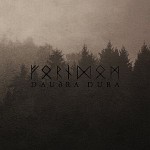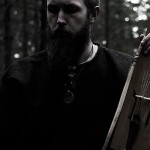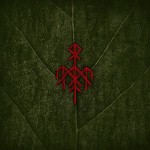 |
| Country: Sweden Genre: neofolk / dark ambient Questions: Skvrn, H. THE SECOND PART OF THE INTERVIEW HERE Links:
|
Swedish neofolk / dark ambient act Forndom gained wider publicity last year after the official release of EP “Flykt” – deservedly, since the record’s atmosphere is quite captivating. The first effort was recently accompanied by the full-length album “Dauðra dura” which was a proper reason to contact H. L. H. Swärd, the mainman behind the band, and ask him a few questions.
The interview is split into two parts. The first one, which focuses on music and other related subjects, follows below. The second one will be published in a few days…
Hello! The very first question will not be much original but it is probably still worth asking – despite I am aware of the fact that you have already answered these things somewhere else. Initially, you started doing music under Heathen Harnow monicker. Why did you decide to change the name to Forndom? And could you also describe the background behind the word “forndom” – its meaning, how did you find it, and how does it fit to the concept and atmosphere of your music?
I started this project firstly as a blog on Tumblr, and the name Heathen Harnow was nothing more than a nickname based upon one of my Danish family names – Harnow. As time went by, this project also got more and more serious and in the end I felt the need to change it into something else. I wanted it to truly have a meaning of what I did and who I was, but yet with a neutral meaning, so I ended up with Forndom. This name is based upon the old Scandinavian word “Fordom” which basically means “Of old”. But we also have another word in Swedish – forn, which means “Ancient” and which often is used in Swedish to mark something that is from the pre-Christian era. So I took this word and ended it with the suffix –dom, creating a word with the meaning “Of what is ancient”.
Can you tell us which instruments exactly are present in the Forndom’s music? Are there any differencies between the “instrumental cast” of “Flykt” and “Dauðra dura”? Do you use any samples, or do you prefer the attitude that everything has to be recorded with real instruments?
It totally depends on if you mean the current instrumental cast or the cast that was used on the last album. On “Flykt” all the instruments was virtual instruments. But in the same time I never recorded this with any thoughts of that it would get so popular. It was simply music written for myself, music that would connect to the many photos I took at the time. But since then I started to take the music more serious, and I started to learn other real instruments. In the last album all the percussion and instruments except for the background ambient drone was recorded with real instruments such as Tagelharpa, Shamandrum, percussion of various kinds, acoustic guitar and näverlur. But this album was also recorded during the summer and some instruments that I actually play, was not included with the songs. If one is to put up the full instrumental cast that I have for the time being it would be:

– Tagelharpa
– Näverlur
– Various Percussion
– Frame drum
– Shaman drum
– Flutes
– Jews Harp
– Vevlira
– Various Ambient sounds
How many instruments are you able to play in total? Are there any instruments whose sound you would like to have in your music but was not able to do so till now? Is there anything you would like to enrich the Forndom’s sound with in the future?
Actually I can’t give an exact number of how many instruments I play. As long as you know how an instrument works, you are able to play it. The more practice you put into it, the better you will become. At least that is how it has always been for me. So I guess it would be easier to answer what instruments I actually use within my music, which I already did. I always strive to have as many old instruments as possible in my music, and even if I told in the last question what instruments I use for the time being, it will certainly be even more until the next release. I’m a big fan of horns of various kinds. Until the next release I will certainly enrich my collection with more birch bark lures (Näverlur) and natural horns.
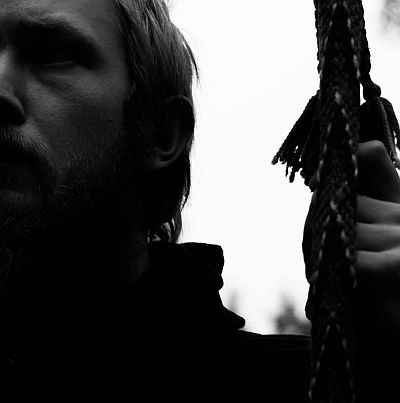
How did you get involved with the music? Is it possible to say which instrument is “the” first one for you? Can you reveal your first musical experiences? Speaking in terms of music, did you do anything before Forndom (Heathen Harnow)?
My father is a cellist so classical music has always been with me as I grew up. My fathers father had a background in a classical orchestra and jazz-band as a contra-bass and piano player. My mother’s father was self taught and could play a number of various folk-instruments. My first instrument to learn was the trumpet, in the age of 7-8. I also learned flute in the same time. My first musical experiences have without doubt been my father playing concerts of Bach, Beethoven, Haydn, Mozart and everyone else of the big composers for me as a child. Without doubt it certainly made me aware of the atmospheres within music, which is of greatest importance for me today. As I were about 12 I started to learn Piano by myself and I also took a few lessons in classical guitar. During the same time I also came in contact with metal-music and during a school-project about Satanism, my teacher told me to take a look at the Black metal scene. I truly enjoyed this music and especially the great atmosphere. I bought myself an electric guitar and started to record some own songs that I uploaded to myspace. It never got any serious though. When I came up into the high-school age I applied to a music-gymnasium in Norrköping where I also got in. For the first time I found friends with an equal taste in music and after some year I created a band called “Eingana” with them. I did the vocals and wrote about half of the songs, but it was all based upon a sound that was to fit all in the band. But within time I felt that it got more and more progressive and lesser and lesser atmospheric. Yet I felt that I was the driving force in the band. So in the end I left. Around this time was also where I started the blog. I left music for some time, later to take it up again.
Forndom is surely connected with your person. Do you do literally everything just on your own? Are there any persons who eventually helped you somehow during composing, recording, or creating the visual form of Forndom?
Yes I do everything on my own. I do have a broad vocal-register, which certainly have made people believe that there are more people involved in this project. But so far it has only been myself doing everything. I do however have plans to include some friends on the vocal part for the next release. Doing everything on your own has its good sides, but it also has its bad sides. Recording and writing everything on your own often makes you very self-critic.
If I am not mistaken, you have not performed live with Forndom so far. However, if I understood one of your recent Facebook statuses correctly, you plan to change that and bring Forndom onstage – is that right? You stated that you will try to solve the necessary circumstances around live playing in the summer. When do you think you will be able to perform live with Forndom?
Yes, that is correct. But I don’t want it to be a performance where I simply stand and perform the regular songs that I’ve written. I want it to be an experience out of the ordinary and this is also why it demands preparation of various kinds. I will certainly be ready to play live during the late autumn/winter of 2016.

What will be your approach to live playing – do you wish to do a regular tour, or do you want to focus rather on occasional single-shot concerts? Actually, I would personally bet on the second option… however, wouldn’t this way bound you to play just in Sweden or eventually in the nearby countries because the expenses for promoters from longer distance would be too high?
I will certainly not tour, but rather focus on single-shot concerts. The plan so far is to write a special live-piece, which will only be performed live and not be bound into the songs I have written so far. The plan is also to perform on my own (with pre-recorded material) and without anyone else included. So I don’t think it would be that very expensive for promoters and arrangers worldwide to make me come and play.
The presentation of Forndom is full of primitive (not in the negative sense of the word), simple, and abstract symbols – which is something I honestly like, way more than some cheesy and kitschy fantasy cartoons. What do the symbols (in general) represent for you? Do you think that the abstraction of primordial symbols is still relevant in the 21st century and today’s society?
The artwork of Forndom is very much based upon Norse religion. But it is not only based upon the myths and saga’s but also upon the mind of old. To understand the mind of old one also has to have a wider understanding for religions of old. When I do my artworks I want them to be simple, but with a deeper meaning. Some people look at them and see what is to be seen, but fail to understand the meaning of it as a whole. I would like to see my artwork as a kind of “Kenning-paintings”. If one knows a lot, one also knows how to interpret what is to be seen. Single symbols might not be relevant into today’s society, but the full context and the thoughts of the human mind, is something that I consider timeless.
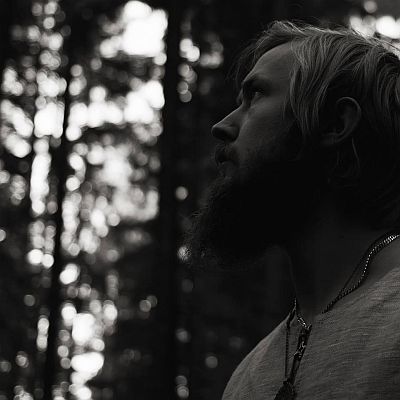
Both “Flykt” and “Dauðra dura” have highly positive response (at least it seems to me like that) which, I guess, is surely quite enjoyable for you. On the other hand, nothing but positive response may cause resting on laurels. Do you have anyone who gives you critical and impartial feedback? And have you ever noticed any negative feedback from the listeners or critics?
Yes, I often send out ideas to the ones closest to my heart. But this is merely just to get the thoughts of somebody else as I often work completely on my own. But in the depth I do not care that very much for what other people think of my work. What I do is simply my own expression and I never do my work to satisfy anyone else than myself. I’m very glad for the great responses I’ve got and it truly means a lot. But it is very seldom that it makes me lesser critic towards myself. So the answer to your question, if good critic makes myself feel more at peace – is no. But ofcourse it is always great to hear that people appreciate what you do and take the music towards them on a very personal level. Because ofcourse this gives you even more motivation. I’ve received some minor negative critics yes and it would in my opinion be strange if I wouldn’t. But people are different, people think different and like different things.
I am sorry to ask so inappropriately but I cannot help myself – your music resembles the works of Norwegian act Wardruna a lot from my point of view. Does this band have any influences on you?
Ofcourse, isn’t that obvious? Wardruna and the music of Einar Selvik had the same impact on me just as bands like Venom and Bathory had a huge impact on the Norwegian black metal scene in the 90’s. Especially when it comes to the use of the many old instruments. But in the same time one also have to have a deeper understanding for why it ended up that way. As I have told already, I have always been into atmospheric music, both classical and black metal. I have since a very young age also had a huge interest for early middle-ages, Vikings and Scandinavian folklore overall. When I created this project under the name of Heathen Harnow, the main idea was to take atmospheric pictures inspired by Scandinavian nature, folklore and myth. After seeing the ritual-ambient act “Draugurinn” on the Swedish festival “Arosian black mass” in 2012, I also decided to contribute the atmosphere of the pictures with music. The foundation of the music was found in the Scandinavian folk tunes, which, except of the regular folkmusic, also can be heard in many of the Swedish lullabies and children-songs, and with other words, it is something that you have with you since a very low age if you are Scandinavian. So to conclude I think one have to see to the big picture to understand why my music also resembles the works of Wardruna. We have the same background and share the same culture.
If I am not mistaken, an early version of “Flykt” released under the old Heathen Harnow name should exist – is that correct? Are there any musical differencies between this early version and the latter editions issued by Nordvis?
Yes that is correct, and this was released digitally during the autumn of 2013 and later physically released on my own during 2014 if I remember it correctly. It was limited to 50 ex and I don’t even have a copy of it myself. The only difference with this edition compared to the one released by Nordvis was that this had two extra tracks which I did the months after releasing it digitally. One of the tracks was named “Skogsrået” and is to be found on YouTube. The other one was an instrumental song called “Minnen ur askan”. But I hope in consideration for the ones who bought it, that it will stay away from the digital world.
The first Nordvis edition of “Flykt” was made as a limited A5 digipack CD (500 copies) which is now out of print. „Dauðra dura” was, among others, released as a limited boxset (150 copies) which is already sold out as well. Are you a fan of such very limited releases which might (and probably will) become rare? Aren’t you afraid of a situation when someone buys it now and then puts it on eBay for enormously high price after some time?
Ofcourse I like limited editions as it put more worth to it. Why should one else have a physical copy of something in the digital world we live in? It is indeed sad that a few people tend to buy limited things just to sell it for a higher price later and I’ve already heard of such cases when it comes to my own releases. But in the same time that is how the market looks for rare works out of artists in general. Paintings tend to be expensive for a reason.
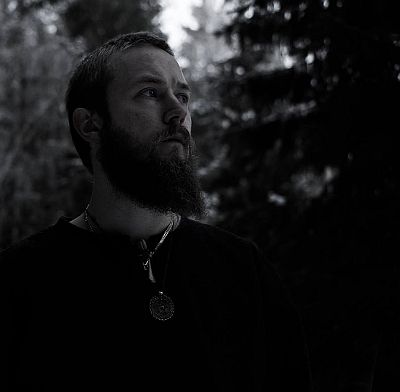
This might be a cliché question but – are there any plans to release “Flykt” and/or “Dauðra dura” on vinyl?
Yes, as announced during the last weeks, DD is coming out on vinyl.
The next question will have a simple form but I guess its answer might not be really plain. The main theme of “Dauðra dura” is death – why did you decide to focus on death?
Death is a natural part of life. Death is not merely something that happens when the body dies, but rather something that goes on continuously throughout our lives. We change and go through passage-rites. We kill the old self to give place for something else, and enter a new part of our lives. But death is also connected with wisdom and learning. In the very darkest stages of our lives we also learn the very most. During the year I was writing this album I learned so many things, both on a physical and psychical level. But I also felt truly bad from time to time because of several reasons, but in the end it was all worth it. My focus upon death was to show that is more to it than just grief and sorrow. Out of every bad thing there is always something good as well.
Despite the fact that “Dauðra dura” is centered around death, there are two songs dealing with different subjects, namely “Svitjod” and “Jag vet ett tempel stå”. Why did you decide to include them on the record instead of having the whole album mono-thematic?
The album is monothematic as these songs are to be connected to the dead and death as well. “Svitjod” is a tribute to the people who lived and died, who sowed and harvested this country in the ages before my own. “Jag vet ett tempel stå” is to be connected with the Uppsala-temple myth, where humans, among many other creatures, were sacrificed to secure a better life for the living.
“Jag vet ett tempel stå” does not contain any vocals but it still has lyrics. Why did you decide not to include any vocals in the track? It may seem a little bit strange, especially when you stated in the liner notes of “Dauðra dura” that one day, you might re-record it with vocals…
The reason for this is simply that I wrote the lyrics after recording everything else of the song, but once recording was to take place, the singing melody I had in mind was too hard to sing in the key it was played in. I tried to make some changes but was never happy enough with the result. By the time I was also about to start my studies again, reading two courses at once that I had to put my focus upon. I was also in general very tired of being in the studio and in the end I decided to leave it as an instrumental song. Though, for coming releases I will probably not sit in sessions writing and recording a whole album as I did here, but rather work on it for shorter sessions.

In the above-mentioned liner notes, you also wrote that you decided not to share English translations or explanation of the album’s lyrics in the booklet. Why? Will you do it some day anywhere else?
I could have translated it word by word, but it would in my opinion not have been a fair result of the lyrics as a whole as it would then exclude rhymes and other things that I find important. But we’ll see, I might post some word-by-word translations via my Tumblr page in the future.
I have also a little question about the fifth song on “Flykt“. Since its name differs on the back cover and on the CD, I would like to know if it is called “Återkomst” or “Återkomsten”?
Hehe, this is probably some minor mistake on Nordvis part then, but it doesn’t matter as it has the same meaning – “Return”. Återkomst is Singular-Undecided-nominative, while Återkomsten is Singular-Decided-nominative. The correct title is “Återkomst”.
THE SECOND PART OF THE INTERVIEW WILL BE PUBLISHED ON 12TH MARCH


